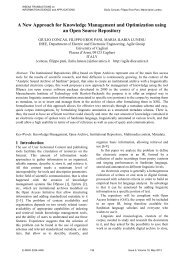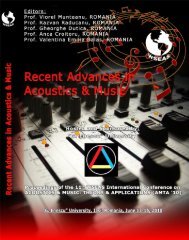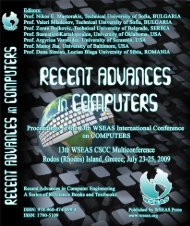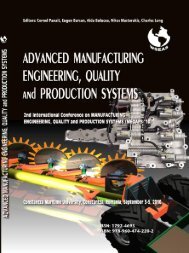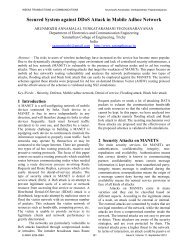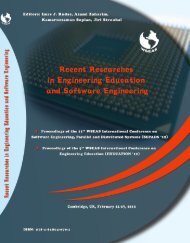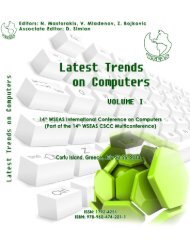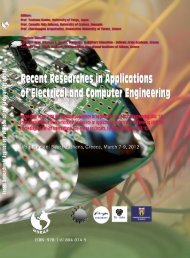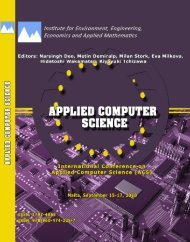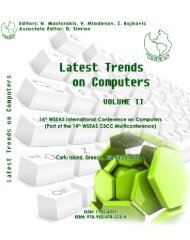Latest Advances in Information Science, Circuits and ... - WSEAS
Latest Advances in Information Science, Circuits and ... - WSEAS
Latest Advances in Information Science, Circuits and ... - WSEAS
- No tags were found...
Create successful ePaper yourself
Turn your PDF publications into a flip-book with our unique Google optimized e-Paper software.
LATEST ADVANCES <strong>in</strong>INFORMATION SCIENCE,CIRCUITS <strong>and</strong> SYSTEMSProceed<strong>in</strong>gs of the 13th <strong>WSEAS</strong> International Conference on NeuralNetworks (NN '12)Proceed<strong>in</strong>gs of the 13th <strong>WSEAS</strong> International Conference on FuzzySystems (FS '12)Proceed<strong>in</strong>gs of the 13th <strong>WSEAS</strong> International Conference onEvolutionary Comput<strong>in</strong>g (EC '12)Proceed<strong>in</strong>gs of the 13th <strong>WSEAS</strong> International Conference onAutomation & <strong>Information</strong> (ICAI '12)Proceed<strong>in</strong>gs of the 1st International Conference on <strong>Circuits</strong>, Systems,Communications, Computers <strong>and</strong> Applications (CSCCA '12)"G. Enescu" University, Iasi, RomaniaJune 13-15, 2012Recent <strong>Advances</strong> <strong>in</strong> Computer Eng<strong>in</strong>eer<strong>in</strong>g Series | 4Published by <strong>WSEAS</strong> Presswww.wseas.orgISSN: 1790-5109ISBN: 978-1-61804-099-2
LATEST ADVANCES <strong>in</strong>INFORMATION SCIENCE,CIRCUITS <strong>and</strong> SYSTEMSProceed<strong>in</strong>gs of the 13th <strong>WSEAS</strong> International Conference on NeuralNetworks (NN '12)Proceed<strong>in</strong>gs of the 13th <strong>WSEAS</strong> International Conference on FuzzySystems (FS '12)Proceed<strong>in</strong>gs of the 13th <strong>WSEAS</strong> International Conference onEvolutionary Comput<strong>in</strong>g (EC '12)Proceed<strong>in</strong>gs of the 13th <strong>WSEAS</strong> International Conference on Automation& <strong>Information</strong> (ICAI '12)Proceed<strong>in</strong>gs of the 1st International Conference on <strong>Circuits</strong>, Systems,Communications, Computers <strong>and</strong> Applications (CSCCA '12)"G. Enescu" University, Iasi, RomaniaJune 13-15, 2012Recent <strong>Advances</strong> <strong>in</strong> Computer Eng<strong>in</strong>eer<strong>in</strong>g Series | 4Published by <strong>WSEAS</strong> Presswww.wseas.orgCopyright © 2012, by <strong>WSEAS</strong> PressAll the copyright of the present book belongs to the World Scientific <strong>and</strong> Eng<strong>in</strong>eer<strong>in</strong>g Academy <strong>and</strong>Society Press. All rights reserved. No part of this publication may be reproduced, stored <strong>in</strong> a retrievalsystem, or transmitted <strong>in</strong> any form or by any means, electronic, mechanical, photocopy<strong>in</strong>g, record<strong>in</strong>g, orotherwise, without the prior written permission of the Editor of World Scientific <strong>and</strong> Eng<strong>in</strong>eer<strong>in</strong>g Academy<strong>and</strong> Society Press.All papers of the present volume were peer reviewed by no less that two <strong>in</strong>dependent reviewers.Acceptance was granted when both reviewers' recommendations were positive.See also: http://www.worldses.org/review/<strong>in</strong>dex.htmlISSN: 1790-5109ISBN: 978-1-61804-099-2World Scientific <strong>and</strong> Eng<strong>in</strong>eer<strong>in</strong>g Academy <strong>and</strong> Society
Hirotaka Inoue, JAPANNaohiro Ishii, JAPANYousuf Mahbubul Islam, BANGLADESHJuri Jatskevich, CANADACheng-chang Jeng, TAIWANZhang Jilong, CHINAC. Jittawiriyanukoon, THAILANDHJ Kadim ,UNITED KINGDOMRihard Karba, SLOVENIAStephen Karungaru, JAPANVictor Kasyanov, RUSSIAOsamu Kata,i JAPANDemetrios Kazakos, UNITED STATESVladimir Kazakov, MEXICOAhad Kazemi, IRANMohamad Khaldi, LEBANONPeter Kokol, SLOVENIASamad Kolahi,NEW ZEALANDChorng-shiuh Koong, TAIWANGuennadi Kouzaev, NORWAYDeniss Kuml<strong>and</strong>er, ESTONIACheng-chien Kuo, TAIWANDan Lascu, ROMANIAMihaela Lascu, ROMANIALjubomir Lazic, YUGOSLAVIAM<strong>in</strong>h Hung Le, AUSTRALIAShih-kai Lee, TAIWANDong-liang Lee, TAIWANSeongkee Lee, KOREAYong Woo Lee, KOREAHuey-M<strong>in</strong>g Lee, TAIWANSomchai Lekcharoen, THAILANDSheng-Tun Li, TAIWANChunshien Li, TAIWANY<strong>in</strong>g Li, TAIWANYim<strong>in</strong>g Li, TAIWAN,Wen-Yew Liang, TAIWANIoan Lie, ROMANIAS. S. L<strong>in</strong>, TAIWANWilfred L<strong>in</strong>, HONG KONG S.A.R.Lily L<strong>in</strong>, TAIWANHongbo Liu, CHINAIsmael Lopez-Juarez, MEXICOYe Lu, CHINAXiaol<strong>in</strong> Lu, CHINADan Macodiyo, JAPANZaigham Mahmood, UNITED KINGDOMBang-on Makdee, THAILANDMr<strong>in</strong>al M<strong>and</strong>a,l CANADAUmar Manzoor, PAKISTANMarius Marcu, ROMANIAYul<strong>in</strong> Mei, CHINAElisabeth Metais, FRANCELiy<strong>in</strong>g Mi, JAPANHannah Michalska, CANADAWasfy Mikhael, UNITED STATESManki M<strong>in</strong>, UNITED STATESHuang M<strong>in</strong>huan, CHINAMihai Mitrea, FRANCEPayman Moallem, IRANNerm<strong>in</strong> Mohamed, EGYPTBouhdai Mohamed, MOROCCOFarah Mohammadi, CANADAS. Amirhassan Monadjemi, IRANBartolomeo Montrucchio, ITALYEduardo Mosqueira-rey, SPAINFRANCEsco Muzi, ITALYIbtissem Nafkha, TUNISIABenedek Nagy, HUNGARYSang-Won Nam, KOREAHamed Nassar, EGYPTPavel Nevriva, CZECH REPUBLICCat Ho Nguyen, VIETNAMElena Niculescu, ROMANIAV<strong>in</strong>cenzo Niola, ITALYJavad Nour<strong>in</strong>ia, IRANJuan Jesus Ocampo-Hidalgo, MEXICOKoji Ohashi, JAPANRol<strong>and</strong> Olsson, NORWAYIgor Ozimek, SLOVENIAAnt nio Pacheco, PORTUGALZeljko Panian, CROATIA (HRVATSKA)Eunkwang Park ,iasiJ<strong>in</strong> Park, UNITED STATESFederico Perez, SPAINAnna Perez, VENEZUELASakthivel Periyasamy, INDIAPisit Phokharatkul, THAILANDOlivier Pons<strong>in</strong>i, FRANCEMircea Popa, ROMANIADan Popescu, ROMANIAMihaela Popescu, ROMANIANenad Popovich NEW ZEALANDAli Pouyan, IRANMarius Preda, FRANCESorapak Pukdesri, THAILANDMohammadreza Rafiei, IRANDejan Rancic, YUGOSLAVIANicolas Ratier, FRANCERab<strong>in</strong> Raut, CANADAFuji Ren, JAPANDimitrios Rigas, UNITED KINGDOMAddison Rios-Bolivar, VENEZUELAFranckl<strong>in</strong> Rivas, VENEZUELAMercedes Ruiz, SPAINJean Saade, LEBANONRaafat Saade, CANADAMohammad Ali Sadrnia, IRANMa Sadrnia, IRANIwata Sakagami, JAPANBouhouche Salah, ALGERIAEnrique San Mill n, SPAINUsiel S<strong>and</strong>ler, ISRAELOscar SanJuan, SPAIN
Michael Schwarz, GERMANYMilos Seda, CZECH REPUBLICTsang-L<strong>in</strong>g Sheu, TAIWANChao-Cheng Shih, TAIWANKhalil Shihab, OMANYUE Shihong, CHINAJeongYon Shim, KOREAYoung-chul Shim, KOREAJungpil Sh<strong>in</strong>, JAPANVairis Shtrauss, LATVIACarmen Simion, ROMANIADharmender S<strong>in</strong>gh Kushwaha, INDIAEfstratios Skafidas, AUSTRALIASuripon Somkuarnpanit, THAILANDHua Song, CHINAArnd Ste<strong>in</strong>metz, GERMANYRodica Stoian, ROMANIAMu-Chun Su, TAIWANPushpa Suri, INDIAMiroslav Sv tek, CZECH REPUBLICFeruglio Sylva<strong>in</strong>, FREANCESab<strong>in</strong> Tabirca, IRELANDRazvan Tanasie, ROMANIAShaohua Tang, CHINAWang Tao, CHINAStanislaw Tarasiewicz, CANADADomenico Tegolo, ITALYKah leng Ter, ROMANIASpyros Tragoudas, UNITED STATESIssa Traore, CANADATsung-Han Tsai, TAIWANRuey-Chyn Tsaur, TAIWANShian-Shyong Tseng, TAIWANJohn Tsiligaridis, UNITED STATESKazuhiko Tsuda, JAPANHassan Ugail, UNITED KINGDOMHans V<strong>and</strong>ierendonck, BELGIUMFrancisco Vasques, PORTUGALCarlos Velez, COLOMBIAFern<strong>and</strong>o Vidal, SPAINLuige Vladareanu, ROMANIAMirela-Catr<strong>in</strong>el Voicu, ROMANIAToshio Wakabayashi, JAPANShum<strong>in</strong>g Wang, TAIWANYi-shun Wang, TAIWANRuye Wang, UNITED STATESL<strong>in</strong> Wilfred, HONG KONG S.A.R.Lai Wux<strong>in</strong>g, CHINATianb<strong>in</strong>g Xia, AUSTRALIAWeiwen Xu, FRANCEKoichi Yamada, JAPANKiyotaka Yamamura, JAPANThomas Yang, UNITED STATESHung-Jen Yang, TAIWANSheng-Yuan Yang, TAIWANKapseung Yang, KOREAShun-Ren Yang, TAIWANHung-Jen Yang, TAIWANP<strong>in</strong>g-Jer Yeh, TAIWANJyh-Yeh, UNITED STATESHsu-Chun Yen, TAIWANEng-Thiam Yeoh, MALAYSIAHuifen Y<strong>in</strong>g, CHINATetsuya Yoshida, JAPANEnhai Yu, CHINAJian Yu ,CHINAEugen Zaharescu, ROMANIANadia Zanzouri, TUNISIADaniel Zapico, SPAINMalika Zazi, MOROCCOWenyu Zhang, CHINAHong Zheng, CHINAHong Zhu, UNITED KINGDOMBlaz Zmazek, SLOVENIAMohammad Al-Amri, UKAdditional Reviewers:Montri PhothisonothaiPavel VarachaMuhammet KoksalAli Dashti shafieiKarim ShiraziMehdi Seyyed AlmasiManuela PanoiuSantoso WibowoAndrzej ZakArianit MarajAlej<strong>and</strong>ro Fuentes-PennaChunwei Lu W<strong>in</strong>i LuMohammad AlshraidehMohd Helmy Abd WahabHime AguiarK K Mishra MishraBautu ElenaClaudio GuarnacciaMário Cesar do Espirito Santo RamosMichele Della VenturaJohn CaterKonstant<strong>in</strong> VolkovShu DaiLarion Al<strong>in</strong>Jose Alberto Duarte MollerPetr HajekZengshi ChenIoana CsakiMuhammad Musaddique Ali RafiqueCatal<strong>in</strong> CroitoruBalcu Flor<strong>in</strong>aDalia SimionCapusneanu Sor<strong>in</strong>elDumitru-Alex<strong>and</strong>ru BodislavArion FelixChirita MioaraJordi Andreu
Am<strong>in</strong> Daneshm<strong>and</strong> MalayeriAw Yoke ChengNikos LoukerisCatal<strong>in</strong> PopescuTakuya YamanoAna BarreiraLadislav TyllPeter ChuVassos VassiliouY<strong>in</strong>-Tsuo HuangHumberto VarumLester IngberAli HennacheCor<strong>in</strong>a SbugheaBadea Ana-CorneliaTiberiu SocaciuYang ZhangVipul Arv<strong>in</strong>dbhai ShahValent<strong>in</strong>a E. BalasColl<strong>in</strong>, Howe H<strong>in</strong>g Tang TangIoan SusneaSor<strong>in</strong> Ioan DeaconuAl<strong>in</strong>a Adriana M<strong>in</strong>eaFarhad MehranMiroslav VoznakHung-Jen YangMihai Timis,MihaiRocco FurferiMatteo PalaiInácio FonsecaTej<strong>in</strong>der SagguGuoxiang LiuMahesh ChavanArdavan RahimianVip<strong>in</strong> BalyanSudha Bhuvaneswari KannanHs<strong>in</strong>-Jang ShiehSvetla VassilevaDalibor BiolekAnkit PatelCor<strong>in</strong>a CarrancaClaudia A.F. AiubSor<strong>in</strong> Ghergh<strong>in</strong>escuFrancisc PopescuIoana DiaconescuDiana-Elena Alex<strong>and</strong>ruAndrei Madal<strong>in</strong>a-TeodoraMuntean Mihaela-CarmenFrancisco D<strong>in</strong>izGheorghe GrigorasCatar<strong>in</strong>a Luisa Camar<strong>in</strong>hasHui WangGoran KoracevicCarlos Rivas-EcheverriaAlex<strong>and</strong>er N. PisarchikKh<strong>in</strong> Wee LaiMohammad Al-AmriLai Kh<strong>in</strong> Wee
PrefaceThis year the 13th <strong>WSEAS</strong> International Conference on Neural Networks (NN '12), the 13th<strong>WSEAS</strong> International Conference on Fuzzy Systems (FS '12), the 13th <strong>WSEAS</strong> InternationalConference on Evolutionary Comput<strong>in</strong>g (EC '12), the 13th <strong>WSEAS</strong> International Conference onAutomation & <strong>Information</strong> (ICAI '12) <strong>and</strong> the 1st International Conference on <strong>Circuits</strong>, Systems,Communications, Computers <strong>and</strong> Applications (CSCCA '12) were held at "G. Enescu"University, Iasi, Romania, June 13-15, 2012. The conferences provided a platform to discussmathematical foundation of neural networks, neural network software, neural networks <strong>and</strong>neuroscience, neural control, fuzzy logic, fuzzy sets, fuzzy algorithms, fuzzy systems <strong>in</strong> robotics<strong>and</strong> mechatronics, evolutionary programm<strong>in</strong>g, neuro-fuzzy-evolutionary systems, molecularcomput<strong>in</strong>g, circuits <strong>and</strong> systems, mobile communications, computer networks, real time systems,microcircuits, military electronics, systems theory, hybrid systems, microwave theory <strong>and</strong>techniques, applied electromagnetics, algorithms <strong>and</strong> theory of computation, network reliability,military communications, <strong>in</strong>telligent agents etc. with participants from all over the world, bothfrom academia <strong>and</strong> from <strong>in</strong>dustry.Their success is reflected <strong>in</strong> the papers received, with participants com<strong>in</strong>g from several countries,allow<strong>in</strong>g a real mult<strong>in</strong>ational multicultural exchange of experiences <strong>and</strong> ideas.The accepted papers of these conferences are published <strong>in</strong> this Book that will be sent to<strong>in</strong>ternational <strong>in</strong>dexes. They will be also available <strong>in</strong> the E-Library of the <strong>WSEAS</strong>. Extendedversions of the best papers will be promoted to many Journals for further evaluation.Conferences such as these can only succeed as a team effort, so the Editors want to thank theInternational Scientific Committee <strong>and</strong> the Reviewers for their excellent work <strong>in</strong> review<strong>in</strong>g thepapers as well as their <strong>in</strong>valuable <strong>in</strong>put <strong>and</strong> advice.The Editors
<strong>Latest</strong> <strong>Advances</strong> <strong>in</strong> <strong>Information</strong> <strong>Science</strong>, <strong>Circuits</strong> <strong>and</strong> SystemsTable of ContentsPlenary Lecture 1: Neural Network Synthesis 15Pavel VarachaPlenary Lecture 2: Applications of fuzzy measures 16Anca CroitoruPlenary Lecture 3: Enhanced Evolutionary Search Algorithms for Multiobjective Optimization<strong>in</strong> Power SystemsMihai Gavrilas17Plenary Lecture 4: Applications of the Concept of Virtual Organization <strong>in</strong> Military Tra<strong>in</strong><strong>in</strong>g 18Mircea BoscoianuPlenary Lecture 5: Mathematical studies applied <strong>in</strong> ball bear<strong>in</strong>gs reliability analysis 19Constant<strong>in</strong> BuzatuPlenary Lecture 6: Automatic Face Detection <strong>and</strong> Recognition Techniques 20Tudor BarbuPlenary Lecture 7: Grammar-Based System Specification for Fun <strong>and</strong> Profit 21Stefan D. BrudaPlenary Lecture 8: Collaborative Eng<strong>in</strong>eer<strong>in</strong>g <strong>in</strong> Product Development of Virtual Enterprises 22Badea LepadatescuPlenary Lecture 9: Development of Mechanical Sensor based on Flat Coil Element 23Mitra DjamalPlenary Lecture 10: Network Cod<strong>in</strong>g: Prelim<strong>in</strong>aries, Theory <strong>and</strong> Implementation 24Zoran BojkovicPlenary Lecture 11: L<strong>and</strong> Use Changes Model<strong>in</strong>g Based on Different Approaches: FuzzyCognitive Maps, Cellular Automata <strong>and</strong> Neural NetworksMaria MoisePlenary Lecture 12: A Bayesian-Reliability Based Approach of Multi-Agent System <strong>in</strong> DynamicEnvironmentsGabriela Tont2526Plenary Lecture 13: Weak-axes bend<strong>in</strong>g vibrations of beams with variable cross-section 27Gilbert-Ra<strong>in</strong>er GillichPlenary Lecture 14: Numerical methods applied <strong>in</strong> electrical circuits 28Carmen M. LungociA Practical Inference Eng<strong>in</strong>e for Risk Assessment of Power Systems based on Hybrid FuzzyInfluence DiagramsAleks<strong>and</strong>ar Janjić, Zoran Stajić, Ivan Radović29ISBN: 978-1-61804-099-2 11
<strong>Latest</strong> <strong>Advances</strong> <strong>in</strong> <strong>Information</strong> <strong>Science</strong>, <strong>Circuits</strong> <strong>and</strong> SystemsComparison of Drug Release Prediction from HPMC Matrices, Effects of Polymer Concentration<strong>and</strong> Physicochemical Properties of Drug by us<strong>in</strong>g Equation <strong>and</strong> Artificial Neural NetworksMahshid Mohammadi, Abdolhosse<strong>in</strong> QaderiKalman Filter <strong>and</strong> Recurrent Neural Network based Hybrid Approach for Space Time BlockCoded-MIMO Set-up with Rayleigh Fad<strong>in</strong>gParismita Gogoi, K<strong>and</strong>arpa Kumar SarmaFuzzy Controller to Improve Motor Pump Group Efficiency <strong>in</strong> a W<strong>in</strong>d Energy Pumped StorageSystemMuhammad M. A. S. Mahmoud354147Fuzzy Algorithm for Parameter Estimation of a Superheater System 55Razidah Ismail, Noor A<strong>in</strong>y HarishProperties of Measurable Multifunctions Relative to a Fuzzy Measure 62Anca CroitoruApply<strong>in</strong>g Target Cost<strong>in</strong>g <strong>in</strong> Comput<strong>in</strong>g the Cost of Products by Us<strong>in</strong>g Fuzzy Quality FunctionDeployment (FQFD)Fatemeh Khajehsharifi, Mohammad Taghi Taghavifard, Jahanyar Bamdad Soofi67K-Vector Fuzzy Integral 73Crist<strong>in</strong>a StamateEnhanced Evolutionary Search Algorithms for Multiobjective Optimization <strong>in</strong> Power System 77Mihai GavrilasMultiobjective Optimization of Capacitor Banks Placement <strong>in</strong> Distribution Networks 87Liva Graff<strong>in</strong> Rakotoarimanana, Mihai Gavrilas, Ovidiu IvanovA Hybrid Differential Evolution – Analytic Hierarchy Process Method for Multi-objectiveOptimizationIulia Coroamă, Mihai Gavrilaş, Ovidiu IvanovModel<strong>in</strong>g <strong>and</strong> Optimization of a Flexible Manufactur<strong>in</strong>g Cell Schedule Us<strong>in</strong>g a Hybrid GeneticAlgorithmDaniel Bancila, Constant<strong>in</strong> Buzatu9399Applications of the Concept of Virtual Organization <strong>in</strong> Military Tra<strong>in</strong><strong>in</strong>g 103Mircea BoşcoianuAspects Regard<strong>in</strong>g the Model<strong>in</strong>g of Intelligent Manufactur<strong>in</strong>g Systems by Us<strong>in</strong>g Grafcet 110Adriana Fota, Mircea BoscoianuUs<strong>in</strong>g Data M<strong>in</strong><strong>in</strong>g Techniques <strong>in</strong> Macroeconomic Analysis on Romania’s Case 116Stelian Stancu, Mircea Boşcoianu, Alex<strong>and</strong>ra Maria Constant<strong>in</strong>Intelligent Exoskeleton Structures for Military Applications 122Ştefan A. Dumitru, Danut A. Bucur, Mircea Boşcoianu, Luige VladareanuThe Automation of the Car Access System us<strong>in</strong>g Logical <strong>Circuits</strong> FPGA 128Gabriel Predusca, Florian Ion, Emil Diaconu, Catal<strong>in</strong> DuscuISBN: 978-1-61804-099-2 12
<strong>Latest</strong> <strong>Advances</strong> <strong>in</strong> <strong>Information</strong> <strong>Science</strong>, <strong>Circuits</strong> <strong>and</strong> SystemsK<strong>in</strong>ematic Solution by MBS Method Applied to Flaps Aircraft Control 133Marius Ghitescu, Ioan EnescuAutomatic Color-based Image Recognition Technique us<strong>in</strong>g LAB Features <strong>and</strong> a RobustUnsupervised Cluster<strong>in</strong>g AlgorithmTudor Barbu, Adrian Ciobanu, Mihaela Cost<strong>in</strong>140Parse Trees for Context Free Parallel Communicat<strong>in</strong>g Grammar Systems 144Stefan D. Bruda, Mary Sarah Ruth Wilk<strong>in</strong>Indoor Thermal Comfort by Controll<strong>in</strong>g Heat Transfer through Build<strong>in</strong>g Envelope 150Daniel Popescu, Cal<strong>in</strong> CiufudeanTheoretical <strong>and</strong> Experimental Study on Cryogenic Freez<strong>in</strong>g of Berries 156Cristian Iosifescu, Valeriu Damian, Cal<strong>in</strong> CiufudeanExperiments with Integration of Classical Manufactur<strong>in</strong>g Devices <strong>in</strong> Intelligent Control Systems 160Valent<strong>in</strong> Vlad, Corneliu Buzduga, Cal<strong>in</strong> CiufudeanA Survey of Livestock Identification Systems 165Maria Vlad, Roxana Andreea Parvulet, Madal<strong>in</strong> Stefan Vlad, Carmen Ana PivodaStock Management <strong>and</strong> Control us<strong>in</strong>g RFID Systems 171Maria Vlad, Madal<strong>in</strong> Stefan VladCollaborative Eng<strong>in</strong>eer<strong>in</strong>g <strong>in</strong> Product Development of Virtual Enterprises 177Lum<strong>in</strong>ita Popa, Badea LepadatescuExperimental Investigation of the Capacitor Influence on the S<strong>in</strong>gle Phase Induction Motor: ALabview ApproachRadu Mera, Radu Câmpeanu184Micropower Low-Pass Filter for Medical Electronics Devices Application 190Walter GermanovixTrends <strong>in</strong> Network Cod<strong>in</strong>g 198Zoran Miličević, Zoran BojkovićAnalysis of a Cyl<strong>in</strong>der-Wire-Cyl<strong>in</strong>der Electrode Configuration dur<strong>in</strong>g Corona Discharge 204K. Kantouna, G. P. Fotis, K. N. Kiousis, L. Ekonomou, G. E. ChatzarakisEmbedded Systems for Monitor<strong>in</strong>g of Temperatures <strong>and</strong> Gases at Large Areas 209Radovan Hajovsky, Mart<strong>in</strong> Pies, Stepan OzanaMathematical Model of Steam Injected <strong>in</strong>to Steam/air Mixture Determ<strong>in</strong>ed for TemperatureControl of Flexible Energy SystemMart<strong>in</strong> Pies, Stepan OzanaModel<strong>in</strong>g, Simulation <strong>and</strong> Design of Control Circuit for Flexible Eenergy System <strong>in</strong> MATLAB &Simul<strong>in</strong>kMart<strong>in</strong> Pies, Stepan Ozana, Radovan HajovskyInfluence of Air Gap Magnetic Induction Variation, Bδ, on the Internal Parameters, Costs <strong>and</strong>Efficiency Synchronous GeneratorSpunei Elisabeta, Piroi Ion214219225ISBN: 978-1-61804-099-2 13
<strong>Latest</strong> <strong>Advances</strong> <strong>in</strong> <strong>Information</strong> <strong>Science</strong>, <strong>Circuits</strong> <strong>and</strong> SystemsThe Influence of Variation the Inner Diameter of the Stator, D, upon the Internal Parameters,the Costs <strong>and</strong> the Efficiency Synchronous GeneratorSpunei Elisabeta, Piroi Ion231Weak-Axis Bend<strong>in</strong>g Vibrations of Beams with Variable Cross-Section 237Gilbert-Ra<strong>in</strong>er Gillich, Zeno-Iosif Praisach, Ionica Negru, Elena Daniela Birdeanu, Nicoleta GillichResearches Regard<strong>in</strong>g Determ<strong>in</strong>ation of Slid<strong>in</strong>g Velocity Between Two Xylan 1052-CoatedHomologous Flanks at Helical Gear WheelsIon-Cornel Mituletu, Ion Vela, Gilbert-Ra<strong>in</strong>er Gillich, Daniel Amariei, Marius Tufoi243Development of Mechanical Sensors Based on Flat Coil Element 248Mitra Djamal, Ellys Mei Sundari, Ratih Kumalasari, RamliL<strong>and</strong> Use Changes Model<strong>in</strong>g Based on Different Approaches: Fuzzy Cognitive Maps, CellularAutomata <strong>and</strong> Neural NetworksMaria Moise254A Fuzzy Cognitive Mapp<strong>in</strong>g Approach for Hous<strong>in</strong>g Affordability Policy Model<strong>in</strong>g 262Marilena-Aura D<strong>in</strong>, Maria MoiseAuthors Index 268ISBN: 978-1-61804-099-2 14
<strong>Latest</strong> <strong>Advances</strong> <strong>in</strong> <strong>Information</strong> <strong>Science</strong>, <strong>Circuits</strong> <strong>and</strong> SystemsPlenary Lecture 1Neural Network SynthesisProfessor Pavel VarachaDepartment of Informatics <strong>and</strong> Artificial IntelligenceFaculty of Applied InformaticsTomas Bata University <strong>in</strong> Zl<strong>in</strong>Czech RepublicE-mail: varacha@fai.utb.czAbstract: The lecture describes a feed forward Artificial Neural Network (ANN) synthesis via an AnalyticProgramm<strong>in</strong>g (AP) by means of the ANN creation, learn<strong>in</strong>g <strong>and</strong> optimization. This process encompasses fourdifferent fields: Evolutionary Algorithms, Symbolic Regression, ANN <strong>and</strong> parallel comput<strong>in</strong>g to successfully synthetizea suitable ANN with<strong>in</strong> a reasonable time. AP performes well <strong>in</strong> many separate cases together with differentevolutionary algorithms as its “eng<strong>in</strong>e”. Direct asynchronous parallelization of SOMA – Self-Organiz<strong>in</strong>g MigrationAlgorithm is applied here to boost AP with unusual efficiency. The ANN synthesis method is applied to the real lifeproblem of Heat Load Prediction function optimization of the heat<strong>in</strong>g plant <strong>in</strong> Komorany (Czech Republic) as well ason cancer classification problem <strong>and</strong> is compared with other methods. ANN synthesis proved to be a useful <strong>and</strong>efficient tool for nonl<strong>in</strong>ear model<strong>in</strong>g <strong>and</strong> its results were applied to <strong>in</strong>telligent system controll<strong>in</strong>g an energeticframework of an urban agglomeration.Brief Biography of the Speaker: Pavel Varacha graduated from Tomas Bata University <strong>in</strong> Zl<strong>in</strong>, Czech Republic <strong>in</strong>2006. In the same year he has started to work as a lecturer on Faculty of Applied Informatics, Tomas Bata University<strong>in</strong> Zl<strong>in</strong>. Pavel Varacha develops <strong>in</strong>novative methods <strong>in</strong> the fields of evolutionary comput<strong>in</strong>g, parallel computation <strong>and</strong>artificial neural network optimization.. S<strong>in</strong>ce 2006 he frequently publishes articles <strong>and</strong> software solutions cover<strong>in</strong>g hisscientific contributions. Between 2006 <strong>and</strong> 2011 he worked as a researcher on National Research Program II, The<strong>in</strong>telligent system controll<strong>in</strong>g an energetic framework of an urban agglomeration (successfully f<strong>in</strong>ished <strong>in</strong> 2011). In2008 he has started to work also <strong>in</strong> College of Logistics, Prerov, Czech Republic. From 2009 he regularly publisheswith<strong>in</strong> <strong>WSEAS</strong> conferences <strong>and</strong> journals. Pavel Varacha has acquired Ph.D. title <strong>in</strong> <strong>Information</strong> Technology fromTomas Bata University <strong>in</strong> Zl<strong>in</strong> (2011). He cont<strong>in</strong>ues his scientific <strong>and</strong> pedagogic work on Department of Informatics<strong>and</strong> Artificial Intelligence, Faculty of Applied Informatics, Tomas Bata University <strong>in</strong> Zl<strong>in</strong>. Presently he is a member of<strong>WSEAS</strong> research project develop<strong>in</strong>g unique method of neural network optimization <strong>and</strong> learn<strong>in</strong>g called NeuralNetwork Synthesis.ISBN: 978-1-61804-099-2 15
<strong>Latest</strong> <strong>Advances</strong> <strong>in</strong> <strong>Information</strong> <strong>Science</strong>, <strong>Circuits</strong> <strong>and</strong> SystemsPlenary Lecture 2Applications of fuzzy measuresProfessor Anca CroitoruFaculty of Mathematics“Al. I Cuza” University of IasiRomaniaE-mail: croitoru@uaic.roAbstract: The importance of fuzzy measure theory, founded by Sugeno <strong>in</strong> 1974, is well known due to its applicationsfor <strong>in</strong>stance <strong>in</strong> statistics, mathematical f<strong>in</strong>ances, human decision mak<strong>in</strong>g, medic<strong>in</strong>e. Our talk refers to some topicssuch as fuzzy set-valued <strong>in</strong>tegrals <strong>and</strong> measurable multifunctions.Brief Biography of the Speaker: Anca Croitoru graduated the Faculty of Mathematics at “Al.I. Cuza” University ofIasi, Romania <strong>and</strong> received the Doctoral Degree <strong>in</strong> Mathematics <strong>in</strong> 2000 at the same university. In present she islecturer at the Faculty of Mathematics, “Al.I. Cuza” University of Iasi, Romania. She is member of AMS, <strong>WSEAS</strong>,ROMAI, EWM, ISCB,“Al. Myller” Mathematical Sem<strong>in</strong>ary Foundation of the Faculty of Mathematics at “Al.I. Cuza” University.She is author or co-author of 6 books (<strong>in</strong> Romanian), over 40 papers <strong>in</strong> national or <strong>in</strong>ternational refereed journals <strong>and</strong>conference proceed<strong>in</strong>gs, co-editor of 7 conference proceed<strong>in</strong>gs, participant at over 40 national or <strong>in</strong>ternationalconference <strong>and</strong> coord<strong>in</strong>ator or member of 4 national <strong>and</strong> 3 <strong>in</strong>ternational research projects.Her research <strong>in</strong>terest <strong>in</strong>cludes multimeasures, fuzzyness <strong>in</strong> measure theory, set-valued <strong>in</strong>tegrals, non-additive setmultifunctions, cont<strong>in</strong>uity <strong>and</strong> measurability of multifunctions.ISBN: 978-1-61804-099-2 16
<strong>Latest</strong> <strong>Advances</strong> <strong>in</strong> <strong>Information</strong> <strong>Science</strong>, <strong>Circuits</strong> <strong>and</strong> SystemsPlenary Lecture 3Enhanced Evolutionary Search Algorithms for Multiobjective Optimization <strong>in</strong> PowerSystemsProfessor Mihai GavrilasDepartmenet of Power Systems«Gheorghe Asachi» Technical University of IasiRomaniaE-mail: mgavrilas@yahoo.comAbstract: The development of electricity networks towards the future smart grids is naturally accompanied by<strong>in</strong>creas<strong>in</strong>g complexity of technical, economical <strong>and</strong> environmental problems. The new challenges require thedevelopment of new techniques <strong>and</strong> optimization methods, <strong>in</strong>clud<strong>in</strong>g specific approaches to multiobjectiveoptimization problems.The presentation will focus on basic <strong>and</strong> multiobjective optimization methods with application to power systemoptimization problems. These methods are based on modern Evolutionary Computation (EC) metaheuristics, namelysearch algorithms based on ordered movement of particles (OMP), such as the Gravitational Search Algorithm (GSA)or the Charged System Search Algorithm (CSSA). As the lecture will emphasize, the performance of these algorithmscan be substantially improved us<strong>in</strong>g an auxiliary mechanism called “dynamic supervision”, specially designed forescap<strong>in</strong>g from local m<strong>in</strong>ima.At the same time, the <strong>in</strong>creas<strong>in</strong>g number of actors <strong>in</strong> the electricity <strong>in</strong>dustry, along with a more distributed nature ofelectricity generation <strong>and</strong> an <strong>in</strong>creas<strong>in</strong>gly active role of consumers <strong>in</strong> the resource management activities, make thedecision mak<strong>in</strong>g process more <strong>and</strong> more based on multiobjective approaches. One of the most <strong>in</strong>terest<strong>in</strong>g issues <strong>in</strong>this context is the optimization problem with conflict<strong>in</strong>g objectives. In this case, beyond the traditional methods suchas the weighted sum of objective functions or the bounded objective function, one of the most commonly usedtechnique is based on the pr<strong>in</strong>ciple of Pareto optimality, <strong>and</strong> can be approached us<strong>in</strong>g methods such as StrengthPareto Evolutionary Algorithm (SPEA) or Nondom<strong>in</strong>ated Sort<strong>in</strong>g Genetic Algorithm (NSGA). Start<strong>in</strong>g from thepr<strong>in</strong>ciple of Pareto optimality, an orig<strong>in</strong>al method for h<strong>and</strong>l<strong>in</strong>g multiobjective optimization problems us<strong>in</strong>g OMP-typesearch algorithms will be described. The method uses non-dom<strong>in</strong>ant sort<strong>in</strong>g <strong>and</strong> particles cluster<strong>in</strong>g based on therank of the Pareto front where each particle was located.The implementation of the proposed search algorithms is demonstrated for the case of a classical power systemsproblem, namely the optimal reactive power compensation or VAR optimization us<strong>in</strong>g capacitor banks.Brief Biography of the Speaker: Mihai Gavrilas was born <strong>in</strong> Iasi, Romania on February, 6, 1959. He received theM.Sc. degree from the “Gheorghe Asachi” Technical University of Iasi, Romania, <strong>in</strong> 1984. Between 1984 <strong>and</strong> 1988 heworked as a field eng<strong>in</strong>eer <strong>and</strong> then as a design eng<strong>in</strong>eer <strong>in</strong> the field of power station <strong>and</strong> substation build<strong>in</strong>g <strong>and</strong>design. S<strong>in</strong>ce 1988 he has been devoted to education <strong>and</strong> research at the “Gheorghe Asachi” Technical University ofIasi, where, at present, he is a professor with the Power System department, at the faculty of Electrical Eng<strong>in</strong>eer<strong>in</strong>g.In 1994 he received the Ph D degree <strong>in</strong> power systems from the Technical University of Iasi. He is read<strong>in</strong>g courseson Power systems steady state <strong>and</strong> stability analysis, Intelligent systems application <strong>in</strong> power systems <strong>and</strong> Electricitymarkets. He has a remarkable scientific <strong>and</strong> educational experience be<strong>in</strong>g the author or jo<strong>in</strong>t author of 11 books, <strong>and</strong>over 140 papers <strong>in</strong> the area of power systems <strong>and</strong> <strong>in</strong>telligent systems applications, published <strong>in</strong> <strong>in</strong>ternational journals<strong>and</strong> conference proceed<strong>in</strong>gs. He also has a valuable project management experience (project manager or member <strong>in</strong>the research team) <strong>in</strong> over 40 research grants sponsored by research organizations <strong>and</strong> / or research programs withpartners from <strong>in</strong>dustry. He is an IEEE member (Power <strong>and</strong> Energy Society, Computational Intelligence Society,Systems, Man <strong>and</strong> Cybernetics Society) s<strong>in</strong>ce 1994 <strong>and</strong> a CIGRE member s<strong>in</strong>ce 2008. His ma<strong>in</strong> research <strong>in</strong>terestsare directed towards multi-objective optimization for power systems steady-state operat<strong>in</strong>g conditions, power systemsdynamics <strong>and</strong> control, state estimation <strong>and</strong> observability analysis <strong>in</strong> power systems, <strong>and</strong> computational <strong>in</strong>telligenceapplication <strong>in</strong> power systems. He participated as a Plenary Speaker <strong>in</strong> the 9-th <strong>WSEAS</strong> / IASME InternationalConference on Electric Power Systems, High Voltages, Electric Mach<strong>in</strong>es (POWER 2009), Genova, Italy <strong>and</strong> the 12-th <strong>WSEAS</strong> International Conference on Mathematical Methods <strong>and</strong> Computational Techniques <strong>in</strong> ElectricalEng<strong>in</strong>eer<strong>in</strong>g (MMACTEE 2010), Timisoara, Romania.ISBN: 978-1-61804-099-2 17
<strong>Latest</strong> <strong>Advances</strong> <strong>in</strong> <strong>Information</strong> <strong>Science</strong>, <strong>Circuits</strong> <strong>and</strong> SystemsPlenary Lecture 4Applications of the Concept of Virtual Organization <strong>in</strong> Military Tra<strong>in</strong><strong>in</strong>gProfessor Mircea Boşcoianu“Henri Co<strong>and</strong>ă” Air Force Academy BraşovROMANIAE-mail: prorector_cercetare@afahc.roAbstract: Multi-Agent System (MAS) is def<strong>in</strong>ed as a group of agents with specific roles <strong>in</strong> the organization whichwork <strong>in</strong> a synergic way (the global contribution represents more then the summarization of the contribution of thecomponents). In real world there is an <strong>in</strong>terest to be oriented on networks, based on a dynamic <strong>and</strong> adaptive processof selection of the abilities <strong>and</strong> capabilities of different actors <strong>and</strong> then fused <strong>in</strong> a s<strong>in</strong>gle entity (cha<strong>in</strong> value concept).This application is <strong>in</strong>spired from the distributive bus<strong>in</strong>ess process (DBP) concept which represents a set ofdynamic/temporary processes orientated on develop<strong>in</strong>g the f<strong>in</strong>al product of Virtual Enterprise (VE). The VE is def<strong>in</strong>ed(Camar<strong>in</strong>ha-Mathos, Afsarmanessh,1999) as a “temporary alliance that come together to share skills or corecompetencies <strong>and</strong> resources <strong>in</strong> order to better respond to bus<strong>in</strong>ess opportunities, <strong>and</strong> who’s cooperation is supportedby computer networks”. The key elements are network<strong>in</strong>g <strong>and</strong> cooperation. A generalized concept of VE isrepresented by Virtual Organization (VO) which represents collaborative networks of organizations that are not limitedby Enterprises.This application is based on the concept of MAS-VE which is designed <strong>and</strong> developed by us<strong>in</strong>g a proper mechanismto susta<strong>in</strong> VO based on the cooperation <strong>in</strong> networks of cha<strong>in</strong> values.The architecture (the functional structure def<strong>in</strong>ed by tak<strong>in</strong>g <strong>in</strong>to the elements of the system <strong>in</strong>terface, processes,constra<strong>in</strong>s <strong>and</strong> behavior) of VO is characterized by a m<strong>in</strong>imal structural def<strong>in</strong>ition, but also by the complexity of tasks<strong>and</strong> restrictions of the processes.MAS-VO should satisfy a dem<strong>and</strong> with maximal efficiency. The flexibility is expressed by the capability to offer a widevariety of different configurations. More flexibility implies a better management of change by us<strong>in</strong>g local decisions <strong>and</strong>then a parallel dissem<strong>in</strong>ation on the whole system.Military tra<strong>in</strong><strong>in</strong>g should consider a multi environment space, <strong>in</strong> which the virtual component of tra<strong>in</strong><strong>in</strong>g should respondto: <strong>in</strong>creased capabilities, embedded <strong>and</strong> tactical subsystems, jo<strong>in</strong>t capabilities. The advantage of a tra<strong>in</strong><strong>in</strong>g support<strong>in</strong>frastructure based on virtual components is expressed by costs, efficiencies, better adaptability, a unique capabilityof battle staffs to synchronized. The concept of synthetic tra<strong>in</strong><strong>in</strong>g environment <strong>and</strong> embedded tra<strong>in</strong><strong>in</strong>g based onvirtual tra<strong>in</strong><strong>in</strong>g systems support comm<strong>and</strong>ers requirements for more efficient tra<strong>in</strong><strong>in</strong>g.In this paper are also presented the emerg<strong>in</strong>g possibilities to improve combat skills <strong>and</strong> leadership formation formilitary students by us<strong>in</strong>g virtual based techniques capable to simulate the complexity of future battle space.Brief Biography of the Speaker: Mircea Boscoianu born at 29.04.1966 <strong>in</strong> Suceava, Romania. He is a Romaniancitizen that graduated the Faculty of Integrated System of Armament, Aerospace Eng<strong>in</strong>eer<strong>in</strong>g <strong>in</strong> the Military TechnicalAcademy of Bucharest (1990) <strong>and</strong> the Faculty of Cybernetics <strong>in</strong> the Academy of Economic Studies of Bucharest(1996). His first PhD was <strong>in</strong> Aerospace Eng<strong>in</strong>eer<strong>in</strong>g (1993-1999) <strong>in</strong> Military Technical Academy <strong>and</strong> the second <strong>in</strong>Cybernetics <strong>and</strong> Statistics (2000-2003) <strong>in</strong> the Academy of Economic Studies of Bucharest.S<strong>in</strong>ce 2009 he is vice-rector of <strong>Science</strong> at Air Force Academy Brasov.His research <strong>and</strong> teach<strong>in</strong>g activities (1990-2009, Military Technical Academy, Dept of Integrated Aeronautical System<strong>and</strong> Mechanics, 2009-2012 Air Force Academy Brasov) covered an extended area of Aerospace Eng<strong>in</strong>eer<strong>in</strong>g,Cybernetics, Statistics <strong>and</strong> <strong>in</strong>terdiscipl<strong>in</strong>ary doma<strong>in</strong> like m<strong>in</strong>i <strong>and</strong> micro, Risk Management, Management of ExtremeRisk Events, Soft Comput<strong>in</strong>g, Artificial Intelligence . He is author/ co-author of more than 120 published papers <strong>and</strong>has contributed to more than 15 books <strong>in</strong> these fields. Mircea Boscoianu has 12 participations <strong>in</strong> <strong>WSEAS</strong>Conferences with 20 papers. He was the Head of Saphire-FAI Program (2006-2008) <strong>and</strong> is member of theAstronautical Commision of the Romanian Academy s<strong>in</strong>ce 2005.Mircea Boscoianu has an <strong>in</strong>terest<strong>in</strong>g experience <strong>in</strong> national projects/ programs (5 projects <strong>in</strong> CNCSIS 2003,CEEX2005,SECURITY 2005,PN2 2007 as general manager <strong>and</strong> many projects as scientifical economical manager).ISBN: 978-1-61804-099-2 18
<strong>Latest</strong> <strong>Advances</strong> <strong>in</strong> <strong>Information</strong> <strong>Science</strong>, <strong>Circuits</strong> <strong>and</strong> SystemsPlenary Lecture 5Mathematical studies applied <strong>in</strong> ball bear<strong>in</strong>gs reliability analysisProfessor Constant<strong>in</strong> BuzatuDepartment of Technological Eng<strong>in</strong>eer<strong>in</strong>g <strong>and</strong> Industrial ManagementTransilvania University of BrasovROMANIAE-mail: cobuzatu@unitbv.roAbstract: The evolutions of stresses <strong>in</strong> mechanical transmissions are not uniform. It was be<strong>in</strong>g developed analysistechniques <strong>and</strong> tests to f<strong>in</strong>d the <strong>in</strong>fluence of r<strong>and</strong>om efforts on the fatigue life. In the paper is presented amathematical program regard<strong>in</strong>g the evaluat<strong>in</strong>g by fatigue us<strong>in</strong>g “ra<strong>in</strong>flow” method, of the <strong>in</strong>fluence the r<strong>and</strong>omstresses on the mechanical parts life.Brief Biography of the Speaker: Constant<strong>in</strong> Buzatu is Professor at the Faculty of Technological Eng<strong>in</strong>eer<strong>in</strong>g <strong>and</strong>Manufactur<strong>in</strong>g Technology Department of Transilvania University of Brasov, Romania. He graduated <strong>in</strong> 1972 <strong>and</strong> heobta<strong>in</strong>ed his Ph.D. <strong>in</strong> the field of accuracy of mach<strong>in</strong><strong>in</strong>g processes. His research <strong>in</strong>terests are <strong>in</strong> Manufactur<strong>in</strong>geng<strong>in</strong>eer<strong>in</strong>g processes, Automation <strong>in</strong> <strong>in</strong>dustry, Performance measurement <strong>and</strong> management, Education technology.He is author <strong>and</strong> co-author of seven books <strong>and</strong> more than 150 papers <strong>in</strong> national <strong>and</strong> <strong>in</strong>ternational conferences. Alsohe has been research manager for several research grants from M<strong>in</strong>istry of Education of Romania, <strong>and</strong> for contractswith factories <strong>in</strong> <strong>in</strong>dustry to <strong>in</strong>troduce new technologies <strong>in</strong> produc<strong>in</strong>g workpieces <strong>and</strong> to improve their reliability. Hewas member of technical program committee of some conferences <strong>and</strong> chairman of local <strong>and</strong> <strong>in</strong>ternationalconferences. He has been scientific reviewer for International Conferences <strong>and</strong> <strong>in</strong>dependent evaluator for GrantNational Competitions.ISBN: 978-1-61804-099-2 19
<strong>Latest</strong> <strong>Advances</strong> <strong>in</strong> <strong>Information</strong> <strong>Science</strong>, <strong>Circuits</strong> <strong>and</strong> SystemsPlenary Lecture 6Automatic Face Detection <strong>and</strong> Recognition TechniquesDr. Tudor BarbuInstitute of Computer <strong>Science</strong> of the Romanian AcademyIasi branchROMANIAE-mail: tudbar@iit.tuiasi.roAbstract: Face recognition has become a very popular field of research <strong>in</strong> computer vision, represent<strong>in</strong>g both apattern recognition <strong>and</strong> biometric doma<strong>in</strong>. It is preferable to many other biometric technologies because of its non<strong>in</strong>trusivecharacter <strong>and</strong> because it is very easy to use. Thus, facial recognition has a critical role <strong>in</strong> biometric systems<strong>and</strong> it is also attractive for numerous applications <strong>in</strong>clud<strong>in</strong>g visual surveillance, access control, robotics <strong>and</strong> securitysystems. Face detection <strong>and</strong> recognition represent two strongly-correlated computer vision processes. Facedetection constitutes the first step for any automatic face recognition system. Although there has been a greatamount of progress <strong>in</strong> face detection <strong>and</strong> recognition so far, numerous issues rema<strong>in</strong> unsolved. In spite of severaldecades of extensive research the development of a computer-based artificial facial recognition system hav<strong>in</strong>gcapabilities comparable with those of human vision systems represents an unachieved goal. Research of human facedetection has to confront many challeng<strong>in</strong>g problems, related to viewpo<strong>in</strong>t, outdoor illum<strong>in</strong>ation, pos<strong>in</strong>g variation withlarge rotation angles, low image quality, low resolution, occlusion, <strong>and</strong> background changes <strong>in</strong> complex real-lifescenes. Artificial face recognition is also quite difficult because of some factors, such as viewpo<strong>in</strong>t, light<strong>in</strong>g conditions,facial expressions, ag<strong>in</strong>g effects <strong>and</strong> occlusions.There are several known categories of face detection approaches: knowledge-based techniques, feature-basedmethods, appearance-based approaches <strong>and</strong> template match<strong>in</strong>g methods. The template match<strong>in</strong>g techniques havebeen the most <strong>in</strong>vestigated dur<strong>in</strong>g our research. We proposed novel face detection approaches based on human sk<strong>in</strong>identification. A sk<strong>in</strong> detection algorithm based on explicitly def<strong>in</strong>ed regions is applied first, then a correlation-basedtemplate-match<strong>in</strong>g process is performed on the detected sk<strong>in</strong> regions. The most popular face recognition techniques<strong>in</strong>clude Eigenfaces, Fisherfaces, L<strong>in</strong>ear Discrim<strong>in</strong>ant Analysis, Elastic Bunch Graph Match<strong>in</strong>g, Hidden MarkovModels, Gabor filter<strong>in</strong>g <strong>and</strong> Dynamic L<strong>in</strong>k Match<strong>in</strong>g neuronal model. Dur<strong>in</strong>g our research we considered orig<strong>in</strong>alfacial recognition techniques based on Eigenfaces <strong>and</strong> Gabor filters. Our Eigenface-based approach is based on the<strong>in</strong>fluential work of Turk <strong>and</strong> Pentl<strong>and</strong>, proposed <strong>in</strong> 1991. A cont<strong>in</strong>uous differential model for face fature extraction isprovided, then the mathematical model is discretized. The second recognition technique uses Gabor filter<strong>in</strong>g <strong>in</strong> thefeature extraction stage. It applies a set of 2D Gabor filters, at various frequencies, orientations <strong>and</strong> st<strong>and</strong>arddeviations, on the facial images. An automatic supervised classifier is used <strong>in</strong> both face authentication cases.Brief Biography of the Speaker: Dr. Tudor Barbu is currently Senior Researcher II at the Institute of Computer<strong>Science</strong> of the Romanian Academy, Ia?i branch. He is the coord<strong>in</strong>ator of an image <strong>and</strong> video process<strong>in</strong>g researchcollective at this <strong>in</strong>stitute. Mr. Barbu has a PhD degree <strong>in</strong> Computer <strong>Science</strong>, awarded by the Faculty of AutomaticControl <strong>and</strong> Computers of the University “Politehnica” of Bucharest.He possess a remarkable research profile. In the last decade he published two books <strong>and</strong> four book chapters ass<strong>in</strong>gle or ma<strong>in</strong> author. Also, dr. Tudor Barbu published more than 60 articles <strong>in</strong> prestigious <strong>in</strong>ternational journals <strong>and</strong>volumes of <strong>in</strong>ternational scientific events (conferences, symposiums <strong>and</strong> workshops). His prolific scientific activityalso <strong>in</strong>cludes more than 30 research reports, elaborated with the <strong>in</strong>stitute research team coord<strong>in</strong>ated by him orrelated to various research projects. His scientific publications have numerous citations, accord<strong>in</strong>g to Google-Academic.In recent years he also coord<strong>in</strong>ated various research directions <strong>in</strong> 6 projects based on contracts/grants. Dr. TudorBarbu received also several awards for his research results, the most important be<strong>in</strong>g the Romanian Academy Prize“Gheorghe Cartianu”, <strong>in</strong> the <strong>Information</strong> <strong>Science</strong> <strong>and</strong> Technology doma<strong>in</strong>, awarded on December 18, 2008. He ismember of several conference scientific committees <strong>and</strong> also member of scientific <strong>and</strong> technical committee <strong>and</strong>editorial review boards of some journals. He is the Editor <strong>in</strong> Chief of a book. His ma<strong>in</strong> scientific areas of <strong>in</strong>terest are:digital media (audio, video <strong>and</strong> image) signal process<strong>in</strong>g <strong>and</strong> analysis, pattern recognition, computer vision,multimedia <strong>in</strong>formation storage, <strong>in</strong>dex<strong>in</strong>g <strong>and</strong> retrieval, <strong>and</strong> biometric authentication us<strong>in</strong>g voice, face <strong>and</strong> digitalf<strong>in</strong>gerpr<strong>in</strong>t recognition.ISBN: 978-1-61804-099-2 20
<strong>Latest</strong> <strong>Advances</strong> <strong>in</strong> <strong>Information</strong> <strong>Science</strong>, <strong>Circuits</strong> <strong>and</strong> SystemsPlenary Lecture 7Grammar-Based System Specification for Fun <strong>and</strong> ProfitAssociate Professor Stefan D. BrudaDept. of Computer <strong>Science</strong>Bishop's UniversityQuebec, CanadaE-mail: stefan@bruda.caAbstract: The specification of programm<strong>in</strong>g languages has long benefited from a powerful system, namely thecontext-free grammar which allows for a natural language specification <strong>and</strong> is then "compiled" <strong>in</strong>to an automaton thatperforms the actual pars<strong>in</strong>g. The same pattern (grammars for specification, automata for implementation) is manifest<strong>in</strong> the realm of formal methods. Here however tools have been essentially limited to a less powerful formalism;<strong>in</strong>deed, most process algebrae used <strong>in</strong> practice for specify<strong>in</strong>g comput<strong>in</strong>g systems are just another name for regulargrammars, which are considerably less expressive than their context-free counterparts. Us<strong>in</strong>g regular grammars thuslimits the constructs that can be specified; recursion <strong>in</strong> particular can only be used <strong>in</strong> very limited forms, which makesthe specification of complex software impossible for all practical purposes. Still, the reason regular grammarscont<strong>in</strong>ue to be the norm <strong>in</strong> formal methods is that certa<strong>in</strong> language-theoretic properties show that context-freelanguages are paradoxically less expressive than regular language <strong>in</strong> the context of system specification, they be<strong>in</strong>gable to model recursion alright, but unable to model other common scenarios such as concurrency. Recently, newtools based on context-free grammars have emerged; such a success rema<strong>in</strong>s however <strong>in</strong> the realm of automata,that is, they do not have any convenient associated "specification language." On-go<strong>in</strong>g research is currentlyattempt<strong>in</strong>g to start on the grammatical side, with the eventual goal of creat<strong>in</strong>g process algebrae that are capable ofh<strong>and</strong>l<strong>in</strong>g both recursion <strong>and</strong> concurrency. In turn, such algebrae will permit complete specifications for complexapplication software, which today are simply too complex to h<strong>and</strong>le. In this talk I will present the effort of go<strong>in</strong>gbeyond regular grammars <strong>in</strong> formal methods. I will summarize the automata side <strong>and</strong> I will also outl<strong>in</strong>e thegrammatical approaches. We will see that such an effort is rich <strong>and</strong> <strong>in</strong>terest<strong>in</strong>g (hence the "fun" <strong>in</strong> the title) <strong>and</strong> alsohas tremendous practical applications (hence the "profit"). On the other h<strong>and</strong>, we will also see that numerouschallenges (both theoretical <strong>and</strong> practical) have yet to be tackled.Brief Biography of the Speaker: Dr. Stefan D. Bruda has a successful career as researcher <strong>in</strong> Computer <strong>Science</strong>,with over 50 publications so far. His research has spanned at least four major areas (formal languages <strong>and</strong> automata,formal methods, parallel computation, <strong>and</strong> artificial <strong>in</strong>telligence). His ma<strong>in</strong> research <strong>in</strong>terest is now formal methods,but he also cont<strong>in</strong>ues to be <strong>in</strong>terested <strong>in</strong> formal languages, more precisely <strong>in</strong> grammatical approaches to parallelism(which will likely be useful <strong>in</strong> the area of formal methods). Dr. Bruda's research has been cont<strong>in</strong>uously funded by amajor federal fund<strong>in</strong>g agency (the National <strong>Science</strong> <strong>and</strong> Eng<strong>in</strong>eer<strong>in</strong>g Research Council of Canada) s<strong>in</strong>ce the start ofhis professional career. His research has also been funded by prov<strong>in</strong>cial agencies <strong>and</strong> other sources. Dr. Bruda actsas an editor for the Parallel Process<strong>in</strong>g Letters journal. He has been active as a reviewer to several conferences,journals (<strong>in</strong>clud<strong>in</strong>g Theoretical Computer <strong>Science</strong> <strong>and</strong> Parallel Process<strong>in</strong>g Letters), <strong>and</strong> fund<strong>in</strong>g agencies (<strong>in</strong>clud<strong>in</strong>gNSERC <strong>in</strong> Canada <strong>and</strong> the CHIST-ERA Consortium <strong>in</strong> the European Union). He has been <strong>in</strong>vited two times asplenary speaker to <strong>in</strong>ternational conferences (but had to decl<strong>in</strong>e one). S<strong>in</strong>ce December 2011 he is a Senior Memberof the Association of Comput<strong>in</strong>g Mach<strong>in</strong>ery (ACM).ISBN: 978-1-61804-099-2 21
<strong>Latest</strong> <strong>Advances</strong> <strong>in</strong> <strong>Information</strong> <strong>Science</strong>, <strong>Circuits</strong> <strong>and</strong> SystemsPlenary Lecture 8Collaborative Eng<strong>in</strong>eer<strong>in</strong>g <strong>in</strong> Product Development of Virtual EnterprisesAssociate Professor Badea LepadatescuTransilvania University of BrasovFaculty of Technological Eng<strong>in</strong>eer<strong>in</strong>g <strong>and</strong> Industrial ManagementDepartment of Manufactur<strong>in</strong>g Eng<strong>in</strong>eer<strong>in</strong>gRomaniaE-mail: lepadatescu@unitbv.roAbstract: Collaborative eng<strong>in</strong>eer<strong>in</strong>g <strong>in</strong> product development is one of the most important requirements for mak<strong>in</strong>gthis Virtual Enterprise real, competitive, <strong>and</strong> widely implemented with<strong>in</strong> organizations. Collaborative Eng<strong>in</strong>eer<strong>in</strong>g is avirtual methodology that tends to br<strong>in</strong>g to upstream knowledge professions <strong>in</strong>volved <strong>in</strong> downstream design aspreparation of manufacture, production <strong>and</strong> market<strong>in</strong>g. It <strong>in</strong>volves effective participation of different professionsspecialists <strong>in</strong> the earliest stages of conception. Mechatronic Integration technology is play<strong>in</strong>g an <strong>in</strong>creas<strong>in</strong>glyimportant role <strong>in</strong> populariz<strong>in</strong>g the concept of end-to-end, cross-functional design. With Mechatronic Integrationmodules, two eng<strong>in</strong>eer<strong>in</strong>g departments share program access <strong>and</strong> <strong>in</strong>telligence, <strong>and</strong> become more productive as aconsequence.Brief Biography of the Speaker: Badea Lepadatescu is currently an Associate Professor at the Faculty ofTechnological Eng<strong>in</strong>eer<strong>in</strong>g <strong>and</strong> Industrial Management of Transylvania University of Brasov, Romania. He obta<strong>in</strong>edhis doctoral degree <strong>in</strong> 1998 <strong>in</strong> the area of mach<strong>in</strong><strong>in</strong>g through superf<strong>in</strong>ish<strong>in</strong>g process. After he graduated he workedfive years as design eng<strong>in</strong>eer at Roman truck factory <strong>in</strong> the field of manufactur<strong>in</strong>g processes where he designedmany devices <strong>and</strong> special mach<strong>in</strong>e tools especially for superf<strong>in</strong>ish<strong>in</strong>g process. Started on 1982 he worked asresearch eng<strong>in</strong>eer at Transilvania University of Brasov, <strong>and</strong> after 1997 he is teach<strong>in</strong>g at Department of Manufactur<strong>in</strong>gEng<strong>in</strong>eer<strong>in</strong>g. His ma<strong>in</strong> academic <strong>in</strong>terests <strong>in</strong>clude Tolerance <strong>and</strong> Dimensional Control, Manufactur<strong>in</strong>g Eng<strong>in</strong>eer<strong>in</strong>gProcesses, Automation Processes, <strong>and</strong> Renewable Energy Sources. The research accomplishments are reflectedthrough publications <strong>in</strong> a five books <strong>and</strong> authored or co-authored over 120 papers published at <strong>in</strong>ternationalconferences. He has extensive experience <strong>in</strong> both experimental <strong>and</strong> theoretical research work hav<strong>in</strong>g more than 50contracts with factories to design <strong>and</strong> produce mach<strong>in</strong>e tools for mach<strong>in</strong><strong>in</strong>g processes. Also <strong>in</strong> the field of RenewableEnergy Sources together with a team he made two w<strong>in</strong>d turb<strong>in</strong>es, one with horizontal axis for tak<strong>in</strong>g water, <strong>and</strong> onewith vertical axis to produce electric energy. He has been speaker to <strong>in</strong>ternational conferences, has moderatedforums, organized symposia, workshops <strong>and</strong> sessions at major <strong>in</strong>ternational conferences.ISBN: 978-1-61804-099-2 22
<strong>Latest</strong> <strong>Advances</strong> <strong>in</strong> <strong>Information</strong> <strong>Science</strong>, <strong>Circuits</strong> <strong>and</strong> SystemsPlenary Lecture 9Development of Mechanical Sensor based on Flat Coil ElementProfessor Mitra DjamalTheoretical High Energy Physics <strong>and</strong> Instrumentation Research GroupFaculty of Mathematics <strong>and</strong> Natural <strong>Science</strong>sInstitut Teknologi B<strong>and</strong>ung (ITB)Jl. Ganesa 10 B<strong>and</strong>ung 40132IndonesiaE-mail: mitra@fi.itb.ac.idAbstract: Distance is a physical quantity that used <strong>in</strong> many applications. In the field of sensor, distance is a ma<strong>in</strong>physical quantity that can be used for many measurements. In this paper, we will show the use of flat coil element formeasur<strong>in</strong>g of very small distance (proximity). Based on this ability, we develop sensors for measur<strong>in</strong>g mechanicalquantities such as pressure, vibration <strong>and</strong> moment of force. As a proximity sensor, the flat coil element is used tomeasure the position of an object (seismic mass) as a function of time. Its work<strong>in</strong>g pr<strong>in</strong>ciple is based on positionchange of a seismic mass that put <strong>in</strong> front of a flat coil element. The flat coil is a part of a LC oscillator; therefore thechange of seismic mass position will change its resonance frequency. Based on the developed flat coil element, wehave successfully developed air pressure sensor. The work<strong>in</strong>g area of the developed pressure sensor can be set byadjust<strong>in</strong>g the membrane thickness. The flat coil element has also been developed for vibration sensor. Vibration likeearthquake is a phenomenon of physics. The characteristics of these vibrations can be used as an early warn<strong>in</strong>gsystem so as to reduce the loss or damage caused by earthquakes. For this purpose the sensor should measurevibration <strong>in</strong> low frequency area. The developed vibration sensor can be used to measure the vibration until 0.2 Hz.F<strong>in</strong>ally, we have succeeded <strong>in</strong> develop<strong>in</strong>g the flat coil element for moment of force sensor. The developed sensorshowed good reproducibility <strong>and</strong> good reliability with relative error under 3%. Sensor models based on mathematicalapproach of each sensor have also been developed.Brief Biography of the Speaker: Mitra Djamal received B.Sc. degree <strong>in</strong> physics from Institut Teknologi B<strong>and</strong>ung <strong>in</strong>1984 <strong>and</strong> the Dr.-Ing. degree <strong>in</strong> electrical <strong>and</strong> electronic eng<strong>in</strong>eer<strong>in</strong>g, especially <strong>in</strong> the field of sensors, <strong>in</strong> Universitaetder Bundeswehr Muenchen, Germany <strong>in</strong> 1992. He jo<strong>in</strong>ed the Faculty of Mathematics <strong>and</strong> Natural <strong>Science</strong>s, ITB,s<strong>in</strong>ce 1986. In 2001 he became Associate Professor <strong>and</strong> became full Professor s<strong>in</strong>ce 2009. His research <strong>in</strong>terest isabout sensors <strong>and</strong> <strong>in</strong>strumentation. Currently he is reviewer of some <strong>in</strong>ternational journals, patent holder of somesensors, member of IEEE, chairman of Indonesian Sensor <strong>and</strong> Actuator System Society (ISASS) <strong>and</strong> vice chairmanof Indonesian Physical Society (HFI). He is also author of more than 125 papers published <strong>in</strong> <strong>in</strong>ternational journals<strong>and</strong> conference proceed<strong>in</strong>gs, <strong>and</strong> <strong>in</strong>vited book chapters.ISBN: 978-1-61804-099-2 23
<strong>Latest</strong> <strong>Advances</strong> <strong>in</strong> <strong>Information</strong> <strong>Science</strong>, <strong>Circuits</strong> <strong>and</strong> SystemsPlenary Lecture 10Network Cod<strong>in</strong>g: Prelim<strong>in</strong>aries, Theory <strong>and</strong> ImplementationProfessor Zoran BojkovicFull Professor of Electrical Eng<strong>in</strong>eer<strong>in</strong>gUniversity of BelgradeSERBIAE-mail: z.bojkovic@yahoo.comAbstract: This presentation aims to be an <strong>in</strong>vitation to eng<strong>in</strong>eers <strong>and</strong> mathematicians to jo<strong>in</strong> the work <strong>in</strong> networktheory <strong>and</strong> implementation, draw<strong>in</strong>g attention to highlights network cod<strong>in</strong>g research from the goals <strong>and</strong> perspectivespo<strong>in</strong>t of view. At the same time, it is of importance to pave the way towards future theoretical <strong>and</strong> practical research<strong>and</strong> development <strong>in</strong> this area. Network cod<strong>in</strong>g (NC) is a new example <strong>in</strong> data transmission that comb<strong>in</strong>es cod<strong>in</strong>g withdata propagation over a network. L<strong>in</strong>ear network cod<strong>in</strong>g (LNC) adopts l<strong>in</strong>ear cod<strong>in</strong>g scheme at every node of thenetwork <strong>and</strong> promises the optimal data transmission rate from the source to all receivers. L<strong>in</strong>earity enhanceseng<strong>in</strong>eer<strong>in</strong>g simplicity which leads to wide applicability. The idea is that the bits <strong>in</strong> <strong>in</strong>formation flows can be mixed aslong as receiv<strong>in</strong>g hosts have received sufficient evidence to reconstruct the orig<strong>in</strong>al packets from the send<strong>in</strong>ghosts.There exists tremendous potential for the theory of NC to affect the design of next generation networkprotocols.In the first part of this presentation, some network cod<strong>in</strong>g pr<strong>in</strong>ciples will be reviewed. Deep connections between LNC<strong>and</strong> algebra will be demonstrated, too. Also, it will be po<strong>in</strong>ted out that employ<strong>in</strong>g cod<strong>in</strong>g at the nodes, networkcapacity can be <strong>in</strong>creased compared with employ<strong>in</strong>g rout<strong>in</strong>g alone <strong>in</strong> the simple network topology known as butterflynetwork. NC may f<strong>in</strong>d practical applications <strong>in</strong> a wide variety of communication networks <strong>and</strong> systems, start<strong>in</strong>g fromcloud comput<strong>in</strong>g systems to mobile applications.On the other h<strong>and</strong>, a key development of network cod<strong>in</strong>g is the factthat the maximum multicast communication capacity can be achieved us<strong>in</strong>g only LNC.The second part of this work, deals with cod<strong>in</strong>g across data which has been put to extensive use <strong>in</strong> today'scommunication systems at l<strong>in</strong>k level. Also, it has been emphasized that applications <strong>in</strong>volv<strong>in</strong>g peer-to-peer (P2P)networks, such as video stream<strong>in</strong>g, may become the most promis<strong>in</strong>g scenario for NC to be deployed <strong>in</strong> real-worldsystems.Conceptually, r<strong>and</strong>om NC may be beneficial <strong>in</strong> both P2P content distribution <strong>and</strong> live stream<strong>in</strong>g systems (NC<strong>in</strong> mobile phones, operational on-dem<strong>and</strong> stream<strong>in</strong>g with r<strong>and</strong>om network cod<strong>in</strong>g). In a wireless sett<strong>in</strong>g, transmitt<strong>in</strong>ga packet from one node to another causes <strong>in</strong>terference to all nearly nodes. If multiple nodes transmit concurently,their waveforms are l<strong>in</strong>early superimposed, which makes it harder for a receiver to recover its desired packets. As forreliable physical layer network cod<strong>in</strong>g, it <strong>in</strong>volves two complementary questions: (a) how to enable encoders <strong>and</strong>decoders to exploit <strong>in</strong>terfer<strong>in</strong>g signals for efficient function computation, <strong>and</strong> (b) at the network level, which functionsto select <strong>in</strong> order to enable efficient overall <strong>in</strong>formation transfer.Brief Biography of the Speaker: Prof. Dr. Zoran Bojkovic (http://www.zoranbojkovic.com) is a Full Professor ofElectrical Engeener<strong>in</strong>g at the University of Belgrade, Serbia, <strong>and</strong> a permanent visit<strong>in</strong>g professor at the University ofTexas at Arl<strong>in</strong>gton, TX, USA, EE Department, Multimedia System Lab. He was a visit<strong>in</strong>g professor <strong>in</strong> more than 20Universities worldwide <strong>and</strong> has taught a number of courses <strong>in</strong> the field of digital signal process<strong>in</strong>g, computernetworks <strong>and</strong> multimedia communications. Prof. Bojkovic is the co-author of 6 <strong>in</strong>ternational books/monographies(Publishers: Prentice-Hall, Wiley, CRC Press, <strong>WSEAS</strong> Press, Editura Politechnica). Some of them have beenpublished <strong>in</strong> Canada, Japan, Ch<strong>in</strong>a, S<strong>in</strong>gapore, India <strong>and</strong> Romania. He is co-editor <strong>in</strong> 68 International Books <strong>and</strong>Conference Proceed<strong>in</strong>gs. He has published more than 430 papers <strong>in</strong> peer-reviewed journals, conferenceproceed<strong>in</strong>gs <strong>and</strong> publications. His activities <strong>in</strong>cluded serv<strong>in</strong>g as Editor-<strong>in</strong>-Chief <strong>in</strong> 2 International Journals <strong>and</strong>Associate Editor <strong>in</strong> 3 International Journals. Prof. Bojkovic was co-chair for more than 10 International Symposium<strong>and</strong> Conferences <strong>and</strong> has served of more than 50 International Symposiums <strong>and</strong> Conferences. He has conductedmany keynote/plenary lectures, workshops/tutorials as well as sem<strong>in</strong>ars <strong>and</strong> participated <strong>in</strong> many <strong>in</strong>ternationalscientific <strong>and</strong> <strong>in</strong>dustrial prjects. He has been <strong>and</strong> is yet a consultant to <strong>in</strong>dustry, research <strong>in</strong>stitutes <strong>and</strong> academia. Heis a Senior Member of IEEE <strong>and</strong> <strong>WSEAS</strong>, Member of EURASIP <strong>and</strong> IASTED, Member of SERSC, Korea, expert ofIAMSET, full member of Eng<strong>in</strong>eer<strong>in</strong>g Academy of Serbia <strong>and</strong> a member of Serbian Scientific Society.ISBN: 978-1-61804-099-2 24
<strong>Latest</strong> <strong>Advances</strong> <strong>in</strong> <strong>Information</strong> <strong>Science</strong>, <strong>Circuits</strong> <strong>and</strong> SystemsPlenary Lecture 11L<strong>and</strong> Use Changes Model<strong>in</strong>g Based on Different Approaches: Fuzzy Cognitive Maps,Cellular Automata <strong>and</strong> Neural NetworksProfessor Maria MoiseFaculty of Computer <strong>Science</strong> for Bus<strong>in</strong>ess ManagementRomanian American UniversityBucharest, ROMANIAE-mail: maria.moise@rau.roAbstract: For model<strong>in</strong>g l<strong>and</strong> use changes there are different approaches based on: Fuzzy Cognitive Maps, CellularAutomata, Neural Network etc. Fuzzy Cognitive Maps (FCMs) approach is a modell<strong>in</strong>g methodology, developed asan expansion of cognitive maps. FCMs belong to the class of neuro–fuzzy systems <strong>and</strong> they are able to <strong>in</strong>corporatehuman knowledge <strong>and</strong> adapt it through learn<strong>in</strong>g procedures. FCMs can be used <strong>in</strong> different fields for example:political developments, organizational behaviour <strong>and</strong> job satisfaction, but also they are capable of modell<strong>in</strong>gscenarios described <strong>in</strong> terms of significant events or concepts <strong>and</strong> their cause-effect relationships. One of the mostuseful aspects of the FCM is its potential for use <strong>in</strong> decision support as a prediction tool, for example given an <strong>in</strong>itialstate of a l<strong>and</strong> use, represented by a set of values of its constituent concepts, a FCM can simulate its evolution overtime to predict its future behaviour. Cellular Automata approach based on Cellular Automata models consists on asimulation environment represented by a grid of space (raster cells), <strong>in</strong> which the state of a cell is chang<strong>in</strong>g to anotherstate by us<strong>in</strong>g a set of transition rules tak<strong>in</strong>g <strong>in</strong>to account the attributes of cells <strong>in</strong> its vic<strong>in</strong>ities. Although CA modelsare widely applied to simulate various spatio-temporal phenomena, particularly for model<strong>in</strong>g l<strong>and</strong> use changes,however the implement<strong>in</strong>g of a CA model <strong>and</strong> its calibration is complicated because there is a large set of parametersof the transition rules <strong>and</strong> also the numerical values of these parameters, that must be f<strong>in</strong>d. For Cellular Automatacalibration there are statistical techniques (logistic <strong>and</strong> multiple regressions, pr<strong>in</strong>cipal component analysis <strong>and</strong>multivariate analysis of variance) <strong>and</strong> computational <strong>in</strong>telligence techniques (neural network, genetic algorithm <strong>and</strong>data m<strong>in</strong><strong>in</strong>g). The Neural Networks have the capacity to recognize <strong>and</strong> classify patterns through tra<strong>in</strong><strong>in</strong>g or learn<strong>in</strong>gprocesses <strong>and</strong> they can be used <strong>in</strong> urban studies. They provide a better performance than the statistical techniques,because they better h<strong>and</strong>le uncerta<strong>in</strong>ties of spatial data. These approaches were proposed <strong>in</strong> the “Future PolicyModel<strong>in</strong>g – FUPOL” project, f<strong>in</strong>anced by FP7 (www.fupol.eu), for model<strong>in</strong>g l<strong>and</strong> use, one of the urban policy doma<strong>in</strong>s,<strong>in</strong> order to support the politicians <strong>and</strong> decision makers of local level for the decision mak<strong>in</strong>g process.Brief Biography of the Speaker: At present, Maria Moise is full-time professor at the Faculty of Computer <strong>Science</strong>for Bus<strong>in</strong>ess Management of the Romanian American University (RAU) of Bucharest, Romania, <strong>and</strong> also she is ViceRector with research activity. Between 1999-2003 she was Dean <strong>and</strong> Rector at AISTEDA University of Bucharest.She received the M. Sc. <strong>in</strong> Mathematics at the University of Bucharest, specialized <strong>in</strong> Operation Research <strong>in</strong> 1972,<strong>and</strong> <strong>in</strong> 1996 she obta<strong>in</strong>ed his doctoral degree <strong>in</strong> Economic Informatics at the Academy of Economic Studies ofBucharest <strong>in</strong> the field of <strong>in</strong>formation systems & <strong>in</strong>telligent systems applied <strong>in</strong> economic area. S<strong>in</strong>ce 1972 until 1999she worked as scientific researcher at National Institute for Research & Development <strong>in</strong> Informatics, <strong>and</strong> also shewas teach<strong>in</strong>g at University of Craiova, Polytechnic University of Bucharest <strong>and</strong> Academy of Economic Studies ofBucharest. Between 1993-1994, Professor Moise obta<strong>in</strong>ed two Research Fellowships at LAFORIA Laboratory of P.M. University, Paris VI <strong>and</strong> she worked <strong>in</strong> the field of Decision Support Systems, Expert Systems <strong>and</strong> Fuzzy Logic.Between 2001-2003 she was st<strong>and</strong><strong>in</strong>g member of Steer<strong>in</strong>g Committee regard<strong>in</strong>g “Promot<strong>in</strong>g Multimedia Access forEducation <strong>and</strong> Tra<strong>in</strong><strong>in</strong>g <strong>in</strong> European Society” - PROMETEUS - EU, as Romanian representative. Her research<strong>in</strong>terests <strong>in</strong>clude <strong>in</strong>telligent systems, neural networks, fuzzy logic, rough sets, mathematic model<strong>in</strong>g, webtechnologies, e-learn<strong>in</strong>g environments, e-bus<strong>in</strong>ess, e-government <strong>and</strong> e-health. She is the author/co-author of 22books <strong>and</strong> over 180 scientific papers. She has extensive experience <strong>in</strong> IT project management, hav<strong>in</strong>g more than 50research contracts funded by National/International Programs. She has been the organizer of severalnational/<strong>in</strong>ternational conferences. She was also national assessor of National Programs (CEEX, PNCDI) <strong>and</strong> alsoEuropean expert at FP6 (e-bus<strong>in</strong>ess) <strong>and</strong> FP7. At present, she is Legal Entity Appo<strong>in</strong>ted Representative-LEAR/Scientific <strong>and</strong> Technical Director from RAU, as partner of FUPOL – Future Policy Model<strong>in</strong>g project, f<strong>in</strong>anced byFP7 (www.fupol.eu).ISBN: 978-1-61804-099-2 25
<strong>Latest</strong> <strong>Advances</strong> <strong>in</strong> <strong>Information</strong> <strong>Science</strong>, <strong>Circuits</strong> <strong>and</strong> SystemsPlenary Lecture 12A Bayesian-Reliability Based Approach of Multi-Agent System <strong>in</strong> Dynamic EnvironmentsAssoc. Professor Gabriela TontControl Systems Eng<strong>in</strong>eer<strong>in</strong>g <strong>and</strong> Management DepartmentFaculty of Electrical Eng<strong>in</strong>eer<strong>in</strong>g <strong>and</strong> <strong>Information</strong> TechnologyUniversity of OradeaROMANIAE-mail: gtont@uoradea.roAbstract: Dynamic model<strong>in</strong>g of multi-agent system <strong>in</strong>teractions <strong>and</strong> model<strong>in</strong>g complex dynamic environmentsrequest devoted dynamic <strong>in</strong>dicators. In complex dynamic environments under conditions of uncerta<strong>in</strong>ty, reliabilitytargets have to be realistic <strong>and</strong> systematically def<strong>in</strong>ed <strong>in</strong> a mean<strong>in</strong>gful way for market<strong>in</strong>g, eng<strong>in</strong>eer<strong>in</strong>g, test<strong>in</strong>g, <strong>and</strong>production. Potential problems proactively identified <strong>and</strong> solved dur<strong>in</strong>g design phase <strong>and</strong> products launched at ornear planned reliability targets elim<strong>in</strong>ate extensive <strong>and</strong> prolonged improvement efforts after start on. The real-lifecomplex development situations express that the methods applied to new product development process contentreliability risks which require assessment <strong>and</strong> quantification at the earliest stage, extract<strong>in</strong>g relevant <strong>in</strong>formation fromthe process. The lecture proposes the computationally efficient adaptive multi-agent approach of estimation of theshape parameters <strong>in</strong> a complex data structures approached with exponential gamma distribution as model of lifetime, reliability <strong>and</strong> failure rate functions <strong>in</strong> multi-agent system <strong>in</strong> complex dynamic environments. The reliability<strong>in</strong>dices of studied systems, approached by the means of Extended Generalized Stochastic Petri Nets (EGSPN) <strong>and</strong> amethod dedicated to nonl<strong>in</strong>ear systems <strong>in</strong>tegrate the collaboration of multiple systems components for the purpose ofproactive <strong>and</strong> adaptive management. The numerical simulation performed <strong>in</strong> the case study validates the correctnessof the proposed methodology.Brief Biography of the Speaker: Gabriela TonŃ earned Ph. D degree <strong>in</strong> Electrical Eng<strong>in</strong>eer<strong>in</strong>g at TechnicalUniversity Cluj Napoca.She is currently an associate professor <strong>in</strong> the Department of Control Systems Eng<strong>in</strong>eer<strong>in</strong>g <strong>and</strong> Management,University of Oradea.She has actively carried out research <strong>and</strong> teach<strong>in</strong>g activities <strong>in</strong> the areas of reliability eng<strong>in</strong>eer<strong>in</strong>g, <strong>and</strong> eng<strong>in</strong>eer<strong>in</strong>gmanagement, multiple participant-multiple objective decision mak<strong>in</strong>g, risk analysis, <strong>and</strong> decision support systems.Most of her research <strong>in</strong>terests lie with<strong>in</strong> the field parallel <strong>and</strong> distributed systems, <strong>and</strong> methodologies to optimally fusemultiple sensors <strong>in</strong>formation <strong>in</strong> robotic systems. Her research areas relate to applied statistics <strong>and</strong> <strong>in</strong>novativeapplications of probability <strong>in</strong> reliability data, accelerated test<strong>in</strong>g, survival analysis, l<strong>in</strong>ear <strong>and</strong> non-l<strong>in</strong>ear.In the fields above she has authored <strong>and</strong> co- authored over 190 scientific publications.As certified external quality auditor, she has extensive experience with six sigma <strong>in</strong>itiatives, optimiz<strong>in</strong>g manufactur<strong>in</strong>gprocesses <strong>and</strong> quality system improvements.She is the Technical Program Co-Chair (<strong>in</strong> 2008) <strong>in</strong> the 9-th <strong>WSEAS</strong> International Conference on Automation <strong>and</strong><strong>Information</strong> (ICAI’ 08), participates <strong>and</strong> reviews for <strong>WSEAS</strong> International Conferences.ISBN: 978-1-61804-099-2 26
<strong>Latest</strong> <strong>Advances</strong> <strong>in</strong> <strong>Information</strong> <strong>Science</strong>, <strong>Circuits</strong> <strong>and</strong> SystemsPlenary Lecture 13Weak-axes bend<strong>in</strong>g vibrations of beams with variable cross-sectionProfessor Gilbert-Ra<strong>in</strong>er GillichFaculty of Mechanics <strong>and</strong> Materials <strong>Science</strong>“Eftimie Murgu” University of ResitaRomaniaE-mail: gillichra<strong>in</strong>er@yahoo.deAbstract: Gilbert-Ra<strong>in</strong>er Gillich is Professor of Vibrations <strong>and</strong> Mach<strong>in</strong>e dynamics at the Faculty of Mechanics <strong>and</strong>materials <strong>Science</strong> of the “Eftimie Murgu” University of Resita - Romania. He earned undergraduate degree <strong>in</strong>Mechanical Eng<strong>in</strong>eer<strong>in</strong>g (1986) <strong>and</strong> PhD degree <strong>in</strong> Strength of materials, elasticity <strong>and</strong> plasticity (1999) at the“Politehnica” University of Timisoara. He ga<strong>in</strong>ed extensive <strong>in</strong>dustrial experience <strong>in</strong> various fields of mechanicaleng<strong>in</strong>eer<strong>in</strong>g, by work<strong>in</strong>g <strong>in</strong> the Steel Factory of Resita, which is completed by teach<strong>in</strong>g <strong>and</strong> research activities at the“Eftimie Murgu” University of Resita <strong>and</strong> the Research Institute for Construction Equipment <strong>and</strong> Technology fromBucharest. These activities are concretized <strong>in</strong> 5 books <strong>and</strong> more than 70 articles <strong>in</strong> reference journals <strong>and</strong><strong>in</strong>ternational conferences, 17 f<strong>in</strong>alized national <strong>and</strong> <strong>in</strong>ternational founded research projects <strong>and</strong> 2 patents. S<strong>in</strong>ce 2002he currently held courses at: Johannes Gutenberg Universitat Ma<strong>in</strong>z (Germany) <strong>and</strong> Universita degli Studi di Sassari(Italy). He is official reviewer of some journals <strong>in</strong>dexed <strong>in</strong> <strong>in</strong>ternational databases <strong>and</strong> was <strong>in</strong>volved <strong>in</strong> organiz<strong>in</strong>g<strong>in</strong>ternational conferences as co-organizer, stream proposer or act<strong>in</strong>g as program committee member or reviewer. Heis member of the International Institute of Acoustics <strong>and</strong> Vibration (IIAV), European Acoustics Association (EAA),European Association for Signal Process<strong>in</strong>g (EURASIP), the Balkan Environmental Association (B.EN.A.), TheGeneral Association of Eng<strong>in</strong>eers <strong>in</strong> Romania (AGIR), Romanian Acoustic Society (SRA), Romanian Association ofTensometry (ARTENS) <strong>and</strong> Robotics Society of Romania (SRR). His research <strong>in</strong>terests are: Applied mechanics <strong>and</strong>vibration; Damage detection; Structural health monitor<strong>in</strong>g; Signal analysis <strong>and</strong> signal process<strong>in</strong>g; Acoustics;Environmental issues.Brief Biography of the Speaker: The paper presents the way how natural frequencies of weak-axis bend<strong>in</strong>gvibration modes of beams change due to discont<strong>in</strong>uities. The authors have contrived a correlation between the stra<strong>in</strong>energy stored <strong>in</strong> a segment of the beam, which is proportional with the mode shape curvature of a consideredfrequency mode at the location where the segment is placed, <strong>and</strong> the frequency change for this mode if damageappears on that segment. The phenomenon is more evident for open cracks, while closed notches have lower<strong>in</strong>fluence on the beam’s dynamic behavior. A general relation was worked out; it permits the calculus of the naturalfrequencies of all bend<strong>in</strong>g modes, for any cross-section area <strong>and</strong> shape, length <strong>and</strong> support type respectively.ISBN: 978-1-61804-099-2 27
<strong>Latest</strong> <strong>Advances</strong> <strong>in</strong> <strong>Information</strong> <strong>Science</strong>, <strong>Circuits</strong> <strong>and</strong> SystemsPlenary Lecture 14Numerical methods applied <strong>in</strong> electrical circuitsLecturer Carmen M. LungociElectrical Eng<strong>in</strong>eer<strong>in</strong>g <strong>and</strong> Computers <strong>Science</strong> FacultyElectrical Eng<strong>in</strong>eer<strong>in</strong>g <strong>and</strong> Applied Psychics DepartmentTransilvania University of BrasovRomaniaE-mail: lungoci@unitbv.roAbstract: In recent years numerical methods are <strong>in</strong>creas<strong>in</strong>gly used because they allow an approach of eng<strong>in</strong>eer<strong>in</strong>gissues of high complexity. An important applicative area of them is given by the electric circuit theory.Electric circuits <strong>in</strong> steady regime require mathematical solv<strong>in</strong>g. The electrical model of a complex circuit is transposed<strong>in</strong>to a mathematical system of l<strong>in</strong>ear equations of higher rank. For solv<strong>in</strong>g this system, direct or iterative algorithmsare implemented. Pr<strong>in</strong>cipal’s numerical methods are briefly reviewed, than an application used <strong>in</strong> electricaleng<strong>in</strong>eer<strong>in</strong>g is detailed. The software developed for runn<strong>in</strong>g the iterative algorithms is presented. On the sameexample, how to apply the theory of graphs is shown. Results of apply<strong>in</strong>g the various numerical algorithms arecompared <strong>and</strong> analyzed.Another important part of electric circuit theory is represented by dynamic circuits. For their solv<strong>in</strong>g, systems ofdifferential equations knowledge are-required. Two methods are detailed <strong>in</strong> this presentation <strong>and</strong> the implementationof them is done.Brief Biography of the Speaker: Carmen Mihaela Lungoci is graduated from Politehnica University, Bucharest,Romania, <strong>in</strong> Automation for Industrial Control field. She worked as RPG programmer on OS systems, than as asenior researcher <strong>in</strong> IT area also. In 2009 she received the Ph.D. degrees <strong>in</strong> Electrical Eng<strong>in</strong>eer<strong>in</strong>g from TransilvaniaUniversity of Brasov. From 2009 she is lecturer at this university, on the Electrical Eng<strong>in</strong>eer<strong>in</strong>g <strong>and</strong> Applied PsychicsDepartment of the Electrical Eng<strong>in</strong>eer<strong>in</strong>g <strong>and</strong> Computers <strong>Science</strong> Faculty. Her current research area deals withapplications of numerical methods <strong>in</strong> electrical eng<strong>in</strong>eer<strong>in</strong>g, energy management <strong>in</strong> automotive systems, energy <strong>and</strong>environment. She published more than 30 articles <strong>in</strong> proceed<strong>in</strong>gs of <strong>in</strong>ternationals conferences <strong>and</strong> journals.ISBN: 978-1-61804-099-2 28
<strong>Latest</strong> <strong>Advances</strong> <strong>in</strong> <strong>Information</strong> <strong>Science</strong>, <strong>Circuits</strong> <strong>and</strong> SystemsAuthors IndexAmariei, D. 243 Gavrilaş, M. 77, 87, 93 Ozana, S. 209, 214, 219Bancila, D. 99 Germanovix, W. 190 Parvulet, R. A. 165Barbu, T. 140 Ghitescu, M. 133 Pies, M. 209, 214, 219Birdeanu, E. D. 237 Gillich, G.-R. 237, 243 Pivoda, A. C. 165Bojković, Z. 198 Gillich, N. 237 Popa, L. 177Bruda, S. D. 144 Gogoi, P. 41 Popescu, D. 150Bucur, D. A. 122 Hajovsky, R. 209, 219 Praisach, Z.-I. 237Buzatu, C. 99 Harish, N. A. 55 Predusca, G. 128Buzduga, C. 160 Ion, E. 128 Qaderi, A. 35Câmpeanu, R. 184 Ion, P. 225, 231 Radović, I. 29Chatzarakis, G. E. 204 Iosifescu, C. 156 Rakotoarimanana, L. G. 87Ciobanu, A. 140 Ismail, R. 55 Ramli 248Ciufudean, C. 150, 156, 160 Ivanov, O. 87, 93 Sarma, K. K. 41Constant<strong>in</strong>, A. M. 116 Janjić, A. 29 Soofi, J. B. 67Coroamă, I. 93 Kantouna, K. 204 Stajić, Z. 29Cost<strong>in</strong>, M. 140 Khajehsharifi, F. 67 Stamate, C. 73Croitoru, A. 62 Kiousis, K. N. 204 Stancu, S. 116Damian, V. 156 Kumalasari, R. 248 Sundari, E. M. 248Diaconu, E. 128 Lepadatescu, B. 177 Taghavifard, M. T. 67D<strong>in</strong>, M.-A. 262 Mahmoud, M. M. A. S. 47 Tufoi, M. 243Djamal, M. 248 Mera, R. 184 Vela, I. 243Dumitru, Ş. A. 122 Miličević, Z. 198 Vlad, M. 165, 171Duscu, C. 128 Mircea Boşcoianu 110, 103 Vlad, M. S. 165, 171Ekonomou, L. 204 Mircea Boşcoianu 116, 122 Vlad, V. 160Elisabeta, S. 225, 231 Mituletu, I.-C. 243 Vladareanu, L. 122Enescu, I. 133 Mohammadi, M. 35 Wilk<strong>in</strong>, M. S. R. 144Fota, A. 110 Moise, M. 254, 262Fotis, G. P. 204 Negru, I. 237ISBN: 978-1-61804-099-2 268




